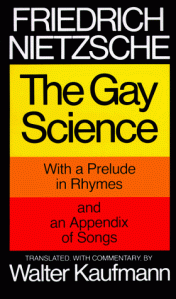Friedrich Nietzsche identifies art as a way to gain perspective on our existence and ease existential nausea, writing in Gay Science 107 (full text available here), “As an aesthetic phenomenon existence is still bearable to us,” creating a front between us and the “nausea and suicide” we realize due to honesty. Honesty (and thus nausea) finds its source in the realization of the inherent meaninglessness of the world of appearances as its witnessed through science and empirical observation — the naturalized perspective Nietzsche argued for throughout his work — instead of a religious lens. Nietzsche’s human is “filled with Dionysian joy and pride in his own artistry,” because without intrinsic order he is led to “the absence of a designing god [leading in turn] to a heightened joy in the artistic possibility of man” (Nussbaum 58). Art helps to bridge the gap between the role of religious order and the chaos that comes once the order is revealed as a delusion (see: “God is dead”); however, the art cannot just exist for its own sake. Art — the right kind of art — and an adaptation of its techniques in the creation of our own identities allows some room for optimism about the human condition because it permits us to create meaning.

An issue remains: Exactly how can we make ourselves into an “aesthetic phenomenon,” as Nietzsche writes in GS 107? The primary solution is self-styling: the use of artistic techniques to craft the self. To make the world, including the self, into an aesthetic phenomenon, not just must the techniques of artists must be copied, but their effects must be integrated into the self as well. Thus, not just the world but the self must be made aesthetic (Young 99). Artistic means are able to achieve this through self-styling, which allows self-deception and artistic perspective, countering honesty and meaninglessness.